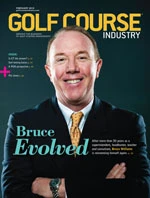The last act in golf course construction is grassing, which usually consists of seeding or sprigging, sodding and placing lots of erosion control protection, whether in the form of straw, hydro-mulch or erosion netting, as each turf type seems to respond to one form more than others.
Actually choosing the appropriate turf types to seed is more difficult than it used to be. With so many quality choices, it’s no longer "bent vs. blue" but also a discussion of exactly which bent to choose. As a transition zone project, the choices were even harder. We discussed grass varieties more than the Mexican drug cartel.
The best fairway grass in Kansas would be Zoyzia, but the budget wouldn’t support total fairway sodding, and the long maturation of planting Zoyzia wasn’t acceptable, so we explored using other types of turf. We first tested for both quantity and quality of water so we knew that neither of those was problematic. We enlisted qualified turf consultants and visited the closest courses with each type of turf we were considering to hear about others’ experiences and see results first hand. We took the results to the client for their input for the final decisions.
For fairways, the choices were low-mow bluegrass, rhizomatous tall fescue (an advanced turf-type tall fescue that mows low, repairs itself quickly that had good results at nearby Colbert Hills), rye and bent. We couldn’t find good looking low-mow bluegrass in the area, despite it working quite well less than 100 miles north. Rye requires overseeding man years. The RTM fescues are surprisingly good, but the team wanted a "luxury look."
Bent and fescues used for rough have similar fertility and irrigation requirements, while bluegrass is quite different in this area, and some recent upscale courses have had great success with bents. Once we were convinced that bent was practical, it was our choice.
That detailed research and selection process took months, and was a precursor to another month to determine exactly which bents would be best for tees, greens and fairways. We had similar debates about which native area grasses to use. The fescue roughs were much easier to decide on, but if seeding deadlines hadn’t loomed, we might still be debating our overall scheme.
We looked at every possible factor, including genetically diverse blends, maintenance requirements like fertility and thatch, visual and play quality, salt and heat tolerance, NTEP ratings and ease of establishment. Costs weren’t considered, since we favored turf we believed would perform best in the long term.
Comforted somewhat by the knowledge that we were splitting hairs among so many so many great choices, we shied away from the "hottest" new varieties. Instead, we gave weight to turfs that were proven under local conditions and moderate maintenance budgets and the recommendations of area superintendents. Their recommendations were surprisingly consistent, in contrast to information overload from other sources. One superintendent at a high-end club chose his green grass type based on Poa resistance, but suggested the same choice as others based on our situation. GCI
I won’t even reveal the final turf choices, having been criticized occasionally by suppliers for mentioning products and brands by name in this column. And, the takeaway from the experience is really that you have more good choices than ever and that choices for your project likely would be very different based on your exact situation anyway. This example merely illustrates the process you might use in selecting turf these days of plenty.
While I may provide some updates, this will conclude my "Design/Construction Journal" series on Firekeeper. We’ll resume our regularly scheduled programming next month! See you then.

Explore the February 2010 Issue
Check out more from this issue and find your next story to read.
Latest from Golf Course Industry
- From the publisher’s pen: Conscientious of a bigger role
- Bernhard and Company partners with Laguna Golf Phuket
- Terre Blanche showcases environmental stewardship
- VIDEO: Introducing our December issue
- Bernhard and Company introduces Soil Scout
- Nu-Pipe donates to GCSAA Foundation’s Centennial Campaign
- GCSAA enhances golf course BMP tool
- Melrose leadership programs sending 18 to 2026 GCSAA Conference and Trade Show





